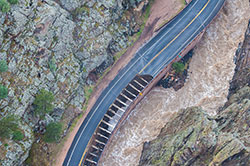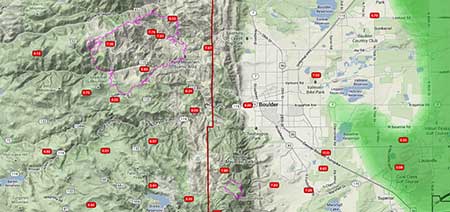The 2013 Colorado Floods
Warning Systems

Many Coloradans lives were changed forever by the rains of September 2013. Over 18,000 homes and businesses were damaged or destroyed by the ensuing floods. Many were uninsured. News reports stated that more than 17 percent of the affected properties in Boulder, Larimer, Logan and Weld counties are not within mapped floodplains. The effect on public transportation was immense with many roads and railway segments completely destroyed. Mountain landslides and streambank failures were common while floodwaters carried huge rocks and debris, carving new channels and creating new floodplains. Statewide flood losses are expected to exceed $2 billion. The record-setting rainstorm was quickly described as a 1000-year event and some accounts even used the term “biblical” to portray the event. While the last comparison may be an overstatement, it certainly was the event of a lifetime for many.
Sadly, the week of heavy rains caused nine fatalities statewide according to the National Weather Service (NWS). Two in El Paso County, one in Clear Creek County, two in Larimer County from flooding on the Big Thompson River and four in Boulder County. Remembering that the 1976 Big Thompson Canyon flash flood claimed over 140 lives, news stories quickly surfaced crediting early flood warning systems with saving hundreds.
The 1976 Big Thompson flood was a catalyst for what followed. Behavioral scientists from the University of Colorado at Boulder were asked to research what people did during the Big Thompson flood, how that flood would have impacted the City of Boulder if it had occurred on Boulder Creek, and what could be done to prevent a similar future catastrophe. Shortly after CU’s findings were revealed, one of the first available color Radar systems was acquired and installed at the NWS Forecast Office in Denver by the Urban Drainage and Flood Control District (UDFCD); a private meteorological service was employed by UDFCD to monitor a second color Radar receiver and provide local officials in the Denver/Boulder metro area with early notifications concerning potential and imminent flood threats; an automated early flood detection network of rain and stream gauges was deployed for the Boulder Creek watershed in Boulder County and later expanded to include many other locations; drainage basin-specific flood warning plans were developed; standard operational procedures were revised to better address flood threats; annual flood exercises were conducted; technological enhancements were constantly introduced; public warning systems were improved; coordination and cooperation among agencies increased; and communications remained a priority.
Prior to and during the September 2013 floods the local flood warning system performed very well. The automated gaging network known as the ALERT System generated over 240 rainfall alarms during the week-long storm period, disseminating notifications to a large number of forecasters, emergency managers, public works officials and others via email and text messages. Stream gages recorded record peaks at 39 locations, logging over 800 alarms. UDFCD, NWS and local emergency management offices worked closely together delivering critical warning messages to response agencies and the public. UDFCD’s private meteorological service produced 162 forecast products and initiated 266 voice contacts with local governments between September 9 and 15. Over 440 NWS communications were relayed by the Denver-regional Emergency Managers Weather Information Network (EMWIN) during that same week. All of this contributed to the situational awareness that local decision makers relied upon to anticipate and react to the circumstances that confronted them.

It is clear that the local flood warning system that evolved over the past 37 years following the Big Thompson Canyon flash flood helped save lives during the September 2013 floods, but the real heroes that deserve the credit are many including: the CU-Boulder behavioral scientists that taught us how people respond to warnings and what could be done to improve the local warning process; community leaders that took this advice seriously by developing better early flood detection capabilities, specialized flood prediction services, siren systems and other enhanced public warning methods; public safety, public works and other local officials that delivered the message to those at highest risk; mountain community alliances that helped citizens know how to survive a wildland fire or flood disaster and established emergency communications for times when normal methods fail; the countless number of skilled emergency service personnel that risked their lives to save others; neighbors helping neighbors; and finally, the people that believed the flood risk message and took appropriate actions when warned.
It will be really interesting how things will be changed after the flood of 2013. I see it as a validation of many policies formed over the last 40 years. This is really the Urban Drainage and Flood Control District’s finest hour. Flood policy and flood-control improvements always follow great flood events.
Terry Gross, Littleton
Although flood-related losses within UDFCD boundaries were significant, many completed drainage and flood control improvements performed quite well and prevented damages. Over the past 40 years UDFCD has worked with its local governments to define flood hazards, to educate people about flood risks, to deploy technologies for detecting floods, to improve early warning capabilities; and to increase the capability of rivers, creeks, gulches and urban drainageways to safely transport floodwaters. After the September floodwaters had receded, one citizen familiar with UDFCD’s work may have said it best when he stated that this was the District’s “finest hour.”
A news release by the National Hydrologic Warning Council observed that Colorado Front Range communities were committed to a “different outcome” than what happened on July 31, 1976 in the Big Thompson Canyon. This statement may best summarize the Colorado recent flood experience. Thirty seven years of preparing for flood disasters using various techniques—not just early warning—undeniably saved lives in September of 2013.
--Kevin Stewart, Manager of Information Services and Flood Warning for the Urban Drainage and Flood Control District
